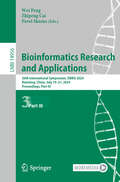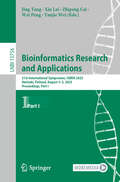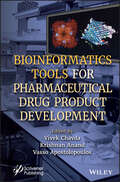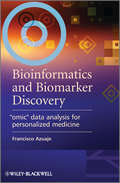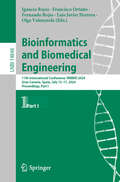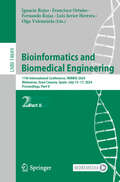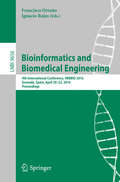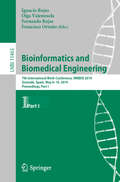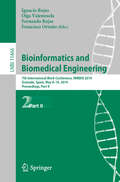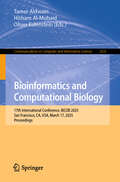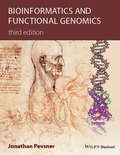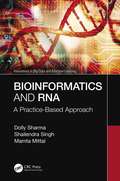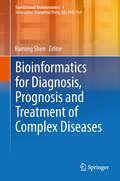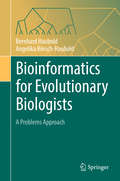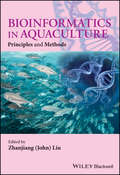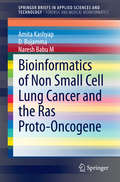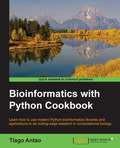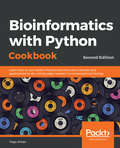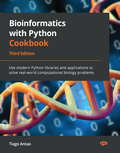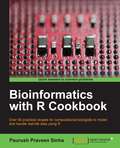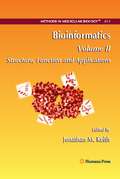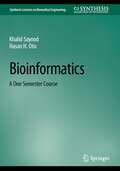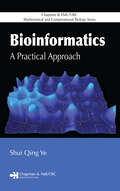- Table View
- List View
Bioinformatics Research and Applications: 20th International Symposium, ISBRA 2024, Kunming, China, July 19–21, 2024, Proceedings, Part II (Lecture Notes in Computer Science #14955)
by Pavel Skums Zhipeng Cai Wei PengThis book constitutes the refereed proceedings of the 20th International Symposium on Bioinformatics Research and Applications, ISBRA 2024, held in Kunming, China, in July 19–21, 2024. The 93 full papers included in this book were carefully reviewed and selected from 236 submissions. The symposium provides a forum for the exchange of ideas and results among researchers, developers, and practitioners working on all aspects of bioinformatics and computational biology and their applications.
Bioinformatics Research and Applications: 20th International Symposium, ISBRA 2024, Kunming, China, July 19–21, 2024, Proceedings, Part III (Lecture Notes in Computer Science #14956)
by Pavel Skums Zhipeng Cai Wei PengThis book constitutes the refereed proceedings of the 20th International Symposium on Bioinformatics Research and Applications, ISBRA 2024, held in Kunming, China, in July 19–21, 2024. The 93 full papers included in this book were carefully reviewed and selected from 236 submissions. The symposium provides a forum for the exchange of ideas and results among researchers, developers, and practitioners working on all aspects of bioinformatics and computational biology and their applications.
Bioinformatics Research and Applications: 21st International Symposium, ISBRA 2025, Helsinki, Finland, August 3–5, 2025, Proceedings, Part I (Lecture Notes in Computer Science #15756)
by Zhipeng Cai Wei Peng Xin Lai Yanjie Wei Jing TangThis two-set volume LNCS 15756 and 15767 constitutes the refereed proceedings of the 21st International Symposium on Bioinformatics Research and Applications, ISBRA 2025, held in Helsinki, Finland, during August 3–5, 2025. The 66 full papers were carefully reviewed and selected from 167 submissions. This year&’s symposium brought together leading researchers, scientists, and industry professionals from around the world to share cutting-edge advancements, foster collaboration, and explore the future of bioinformatics and computational biology.
Bioinformatics Tools for Pharmaceutical Drug Product Development
by Krishnan Anand Vivek Chavda Vasso ApostolopoulosBIOINFORMATICS TOOLS FOR Pharmaceutical DRUG PRODUCT DLEVELOPMENT A timely book that details bioinformatics tools, artificial intelligence, machine learning, computational methods, protein interactions, peptide-based drug design, and omics technologies, for drug development in the pharmaceutical and medical sciences industries. The book contains 17 chapters categorized into 3 sections. The first section presents the latest information on bioinformatics tools, artificial intelligence, machine learning, computational methods, protein interactions, peptide-based drug design, and omics technologies. The following 2 sections include bioinformatics tools for the pharmaceutical sector and the healthcare sector. Bioinformatics brings a new era in research to accelerate drug target and vaccine design development, improving validation approaches as well as facilitating and identifying side effects and predicting drug resistance. As such, this will aid in more successful drug candidates from discovery to clinical trials to the market, and most importantly make it a more cost-effective process overall. Readers will find in this book: Applications of bioinformatics tools for pharmaceutical drug product development like process development, pre-clinical development, clinical development, commercialization of the product, etc.; The ever-expanding application of this novel technology and discusses some of the unique challenges associated with such an approach; The broad and deep background, as well as updates, on recent advances in both medicine and AI/ML that enable the application of these cutting-edge bioinformatics tools. Audience The book will be used by researchers and scientists in academia and industry including drug developers, computational biochemists, bioinformaticians, immunologists, pharmaceutical and medical sciences, as well as those in artificial intelligence and machine learning.
Bioinformatics and Biomarker Discovery
by Francisco AzuajeThis book is designed to introduce biologists, clinicians and computational researchers to fundamental data analysis principles, techniques and tools for supporting the discovery of biomarkers and the implementation of diagnostic/prognostic systems.The focus of the book is on how fundamental statistical and data mining approaches can support biomarker discovery and evaluation, emphasising applications based on different types of "omic" data. The book also discusses design factors, requirements and techniques for disease screening, diagnostic and prognostic applications.Readers are provided with the knowledge needed to assess the requirements, computational approaches and outputs in disease biomarker research. Commentaries from guest experts are also included, containing detailed discussions of methodologies and applications based on specific types of "omic" data, as well as their integration. Covers the main range of data sources currently used for biomarker discoveryCovers the main range of data sources currently used for biomarker discoveryPuts emphasis on concepts, design principles and methodologies that can be extended or tailored to more specific applicationsOffers principles and methods for assessing the bioinformatic/biostatistic limitations, strengths and challenges in biomarker discovery studiesDiscusses systems biology approaches and applicationsIncludes expert chapter commentaries to further discuss relevance of techniques, summarize biological/clinical implications and provide alternative interpretations
Bioinformatics and Biomedical Engineering: 11th International Conference, IWBBIO 2024, Meloneras, Gran Canaria, Spain, July 15–17, 2024, Proceedings, Part I (Lecture Notes in Computer Science #14848)
by Ignacio Rojas Francisco Ortuño Olga Valenzuela Fernando Rojas Luis Javier HerreraThis volume constitutes the proceedings of the 11th International Work-Conference on IWBBIO 2023, held in Gran Canaria, Spain, during July 15-17, 2022. The 54 full papers were carefully reviewed and selected from 148 submissions. They were organized in the following topical sections: Biomarker Identification, Biomedical Engineering, Biomedical Signal Analysis, E-Health.
Bioinformatics and Biomedical Engineering: 11th International Conference, IWBBIO 2024, Meloneras, Gran Canaria, Spain, July 15–17, 2024, Proceedings, Part II (Lecture Notes in Computer Science #14849)
by Ignacio Rojas Francisco Ortuño Olga Valenzuela Fernando Rojas Luis Javier HerreraThis volume constitutes the proceedings of the 11th International Work-Conference on IWBBIO 2023, held in Meloneras, Gran Canaria, Spain, during July 15-17, 2022. The 54 full papers were carefully reviewed and selected from 148 submissions. They were organized in the following topical sections: Healthcare and Diseases, Machine Learning in Bioinformatics, New Advances in Deep Learning in Bioinformatics and Biomedicine, Novel Methodologies and Applications in Bioinformatics and Biomedicine.
Bioinformatics and Biomedical Engineering: 4th International Conference, IWBBIO 2016, Granada, Spain, April 20-22, 2016, Proceedings (Lecture Notes in Computer Science #9656)
by Ignacio Rojas Francisco OrtuñoThis book constitutes the refereed proceedings of the 4th International Conference on Bioinformatics and Biomedical Engineering, IWBBIO 2016, held in Granada, Spain, in April 2016. The 69 papers presented were carefully reviewed and selected from 286 submissions. The scope of the conference spans the following areas: bioinformatics for healthcare and diseases; biomedical image analysis; biomedical signal analysis; computational systems for modeling biological processes; eHealth; tools for next generation sequencing data analysis; assistive technology for people with neuromotor disorders; fundamentals of biological dynamics and maximization of the information extraction from the experiments in the biological systems; high performance computing in bioinformatics, computational biology and computational chemistry; human behavior monitoring, analysis and understanding; pattern recognition and machine learning in the -omics sciences; and resources for bioinformatics.
Bioinformatics and Biomedical Engineering: 7th International Work-Conference, IWBBIO 2019, Granada, Spain, May 8-10, 2019, Proceedings, Part I (Lecture Notes in Computer Science #11465)
by Ignacio Rojas Francisco Ortuño Olga Valenzuela Fernando RojasThe two-volume set LNBI 11465 and LNBI 11466 constitutes the proceedings of the 7th International Work-Conference on Bioinformatics and Biomedical Engineering, IWBBIO 2019, held in Granada, Spain, in May 2019. The total of 97 papers presented in the proceedings, was carefully reviewed and selected from 301 submissions. The papers are organized in topical sections as follows: Part I: High-throughput genomics: bioinformatics tools and medical applications; omics data acquisition, processing, and analysis; bioinformatics approaches for analyzing cancer sequencing data; next generation sequencing and sequence analysis; structural bioinformatics and function; telemedicine for smart homes and remote monitoring; clustering and analysis of biological sequences with optimization algorithms; and computational approaches for drug repurposing and personalized medicine. Part II: Bioinformatics for healthcare and diseases; computational genomics/proteomics; computational systems for modelling biological processes; biomedical engineering; biomedical image analysis; and biomedicine and e-health.
Bioinformatics and Biomedical Engineering: 7th International Work-Conference, IWBBIO 2019, Granada, Spain, May 8-10, 2019, Proceedings, Part II (Lecture Notes in Computer Science #11466)
by Ignacio Rojas Francisco Ortuño Olga Valenzuela Fernando RojasThe two-volume set LNBI 11465 and LNBI 11466 constitutes the proceedings of the 7th International Work-Conference on Bioinformatics and Biomedical Engineering, IWBBIO 2019, held in Granada, Spain, in May 2019. The total of 97 papers presented in the proceedings, was carefully reviewed and selected from 301 submissions. The papers are organized in topical sections as follows: Part I: High-throughput genomics: bioinformatics tools and medical applications; omics data acquisition, processing, and analysis; bioinformatics approaches for analyzing cancer sequencing data; next generation sequencing and sequence analysis; structural bioinformatics and function; telemedicine for smart homes and remote monitoring; clustering and analysis of biological sequences with optimization algorithms; and computational approaches for drug repurposing and personalized medicine. Part II: Bioinformatics for healthcare and diseases; computational genomics/proteomics; computational systems for modelling biological processes; biomedical engineering; biomedical image analysis; and biomedicine and e-health.
Bioinformatics and Computational Biology: 17th International Conference, BICOB 2025, San Francisco, CA, USA, March 17, 2025, Proceedings (Communications in Computer and Information Science #2535)
by Oliver Eulenstein Tamer Aldwairi Hisham Al-MubaidThis book constitutes the refereed proceedings of the 17th International Conference on Bioinformatics and Computational Biology, BICOB 2025, held in San Francisco, CA, USA, on March 17, 2025.The 18 full papers presented in this book were carefully reviewed and selected from 38 submissions.The papers cover a wide range of bioinformatics and computational biology topics, including bioinformatics algorithms, genomics, machine learning applications in bioinformatics, and medical informatics.
Bioinformatics and Functional Genomics
by Jonathan PevsnerThe bestselling introduction to bioinformatics and functional genomics--now in an updated editionWidely received in its previous edition, Bioinformatics and Functional Genomics offers the most broad-based introduction to this explosive new discipline. Now in a thoroughly updated and expanded Second Edition, it continues to be the go-to source for students and professionals involved in biomedical research.This edition provides up-to-the-minute coverage of the fields of bioinformatics and genomics. Features new to this edition include:Several fundamentally important proteins, such as globins, histones, insulin, and albumins, are included to better show how to apply bioinformatics tools to basic biological questions.A completely updated companion web site, which will be updated as new information becomes available - visit www.wiley.com/go/pevsnerbioinformaticsDescriptions of genome sequencing projects spanning the tree of life.A stronger focus on how bioinformatics tools are used to understand human disease.The book is complemented by lavish illustrations and more than 500 figures and tables--fifty of which are entirely new to this edition. Each chapter includes a Problem Set, Pitfalls, Boxes explaining key techniques and mathematics/statistics principles, Summary, Recommended Reading, and a list of freely available software. Readers may visit a related Web page for supplemental information at www.wiley.com/go/pevsnerbioinformatics.Bioinformatics and Functional Genomics, Second Edition serves as an excellent single-source textbook for advanced undergraduate and beginning graduate-level courses in the biological sciences and computer sciences. It is also an indispensable resource for biologists in a broad variety of disciplines who use the tools of bioinformatics and genomics to study particular research problems; bioinformaticists and computer scientists who develop computer algorithms and databases; and medical researchers and clinicians who want to understand the genomic basis of viral, bacterial, parasitic, or other diseases.Praise for the first edition:"...ideal both for biologists who want to master the application of bioinformatics to real-world problems and for computer scientists who need to understand the biological questions that motivate algorithms." Quarterly Review of Biology"... an excellent textbook for graduate students and upper level undergraduate students." Annals of Biomedical Engineering"...highly recommended for academic and medical libraries, and for researchers as an introduction and reference..." E-Streams
Bioinformatics and RNA: A Practice-Based Approach (Innovations in Big Data and Machine Learning)
by Mamta Mittal Shailendra Singh Dolly SharmaThis book offers a unique balance between a basic introductory knowledge of bioinformatics and a detailed study of algorithmic techniques. Bioinformatics and RNA: A Practice-Based Approach is a complete guide on the fundamental concepts, applications, algorithms, protocols, new trends, challenges, and research results in the area of bioinformatics and RNA.The book offers a broad introduction to the explosively growing new discipline of bioinformatics. It covers theoretical topics along with computational algorithms. It explores RNA bioinformatics, which contribute to therapeutics and drug discovery. Implementation of algorithms in a DotNet Framework with code and complete insight on the state-of-the-art and recent advancements are presented in detail. The book targets both novice readers as well as practitioners in the field. FEATURES Offers a broad introduction to the explosively growing new discipline of bioinformatics Covers theoretical topics and computational algorithms Explores RNA bioinformatics to unleash the potential from therapeutics to drug discovery Discusses implementation of algorithms in DotNet Frameworks with code Presents insights into the state of the art and recent advancements in bioinformatics The book is useful to undergraduate students with engineering, science, mathematics, or biology backgrounds. Researchers will be equally interested.
Bioinformatics for Biologists
by Pavel Pevzner Ron ShamirThe computational education of biologists is changing to prepare students for facing the complex datasets of today's life science research. In this concise textbook, the authors' fresh pedagogical approaches lead biology students from first principles towards computational thinking. A team of renowned bioinformaticians take innovative routes to introduce computational ideas in the context of real biological problems. Intuitive explanations promote deep understanding, using little mathematical formalism. Self-contained chapters show how computational procedures are developed and applied to central topics in bioinformatics and genomics, such as the genetic basis of disease, genome evolution or the tree of life concept. Using bioinformatic resources requires a basic understanding of what bioinformatics is and what it can do. Rather than just presenting tools, the authors – each a leading scientist – engage the students' problem-solving skills, preparing them to meet the computational challenges of their life science careers.
Bioinformatics for Diagnosis, Prognosis and Treatment of Complex Diseases (Translational Bioinformatics #4)
by Bairong ShenThe book introduces the bioinformatics tools, databases and strategies for the translational research, focuses on the biomarker discovery based on integrative data analysis and systems biological network reconstruction. With the coming of personal genomics era, the biomedical data will be accumulated fast and then it will become reality for the personalized and accurate diagnosis, prognosis and treatment of complex diseases. The book covers both state of the art of bioinformatics methodologies and the examples for the identification of simple or network biomarkers. In addition, bioinformatics software tools and scripts are provided to the practical application in the study of complex diseases. The present state, the future challenges and perspectives were discussed. The book is written for biologists, biomedical informatics scientists and clinicians, etc. Dr. Bairong Shen is Professor and Director of Center for Systems Biology, Soochow University; he is also Director of Taicang Center for Translational Bioinformatics.
Bioinformatics for Evolutionary Biologists: A Problems Approach
by Bernhard Haubold Angelika Börsch-HauboldThis self-contained textbook covers fundamental aspects of sequence analysis in evolutionary biology, including sequence alignment, phylogeny reconstruction, and coalescent simulation. It addresses these aspects through a series of over 400 computer problems, ranging from elementary to research level to enable learning by doing. Students solve the problems in the same computational environment used for decades in science - the UNIX command line. This is available on all three major operating systems for PCs: Microsoft Windows, Mac-OSX, and Linux. To learn using this powerful system, students analyze sample sequence data by applying generic tools, bioinformatics software, and over 40 programs specifically written for this course. The solutions for all problems are included, making the book ideal for self-study. Problems are grouped into sections headed by an introduction and a list of new concepts and programs. By using practical computing to explore evolutionary concepts and sequence data, the book enables readers to tackle their own computational problems.
Bioinformatics in Aquaculture: Principles and Methods
by Zhanjiang John LiuBioinformatics derives knowledge from computer analysis of biological data. In particular, genomic and transcriptomic datasets are processed, analysed and, whenever possible, associated with experimental results from various sources, to draw structural, organizational, and functional information relevant to biology. Research in bioinformatics includes method development for storage, retrieval, and analysis of the data. Bioinformatics in Aquaculture provides the most up to date reviews of next generation sequencing technologies, their applications in aquaculture, and principles and methodologies for the analysis of genomic and transcriptomic large datasets using bioinformatic methods, algorithm, and databases. The book is unique in providing guidance for the best software packages suitable for various analysis, providing detailed examples of using bioinformatic software and command lines in the context of real world experiments. This book is a vital tool for all those working in genomics, molecular biology, biochemistry and genetics related to aquaculture, and computational and biological sciences.
Bioinformatics of Non Small Cell Lung Cancer and the Ras Proto-Oncogene (SpringerBriefs in Applied Sciences and Technology)
by Amita Kashyap D. Bujamma Naresh Babu MCancer is initiated by activation of oncogenes or inactivation of tumor suppressor genes. Mutations in the K-ras proto-oncogene are responsible for 10-30% of adenocarcinomas. Clinical Findings point to a wide variety of other cancers contributing to lung cancer incidence. Such a scenario makes identification of lung cancer difficult and thus identifying its mechanisms can contribute to the society. Identifying unique conserved patterns common to contributing proto-oncogenes may further be a boon to Pharmacogenomics and pharmacoinformatics. This calls for ab initio/de novo drug discovery that in turn will require a comprehensive in silico approach of Sequence, Domain, Phylogenetic and Structural analysis of the receptors, ligand screening and optimization and detailed Docking studies. This brief involves extensive role of the RAS subfamily that includes a set of proteins, which cause an over expression of cancer-causing genes like M-ras and initiate tumour formation in lungs. SNP Studies and Structure based drug discovery will also be undertaken.
Bioinformatics with Python Cookbook
by Tiago AntaoIf you have intermediate-level knowledge of Python and are well aware of the main research and vocabulary in your bioinformatics topic of interest, this book will help you develop your knowledge further.
Bioinformatics with Python Cookbook - Second Edition
by Tiago AntaoThis book is for Data Scientists, Bioinformatics analysts, researchers, and Python developers who want to address intermediate-to-advanced common biological and bioinformatics problems with the recipe-based approach. Working knowledge of Python programming language is expected.
Bioinformatics with Python Cookbook: Use modern Python libraries and applications to solve real-world computational biology problems, 3rd Edition
by Tiago AntaoDiscover modern, next-generation sequencing libraries from the powerful Python ecosystem to perform cutting-edge research and analyze large amounts of biological dataKey FeaturesPerform complex bioinformatics analysis using the most essential Python libraries and applicationsImplement next-generation sequencing, metagenomics, automating analysis, population genetics, and much moreExplore various statistical and machine learning techniques for bioinformatics data analysisBook DescriptionBioinformatics is an active research field that uses a range of simple-to-advanced computations to extract valuable information from biological data, and this book will show you how to manage these tasks using Python.This updated third edition of the Bioinformatics with Python Cookbook begins with a quick overview of the various tools and libraries in the Python ecosystem that will help you convert, analyze, and visualize biological datasets. Next, you'll cover key techniques for next-generation sequencing, single-cell analysis, genomics, metagenomics, population genetics, phylogenetics, and proteomics with the help of real-world examples. You'll learn how to work with important pipeline systems, such as Galaxy servers and Snakemake, and understand the various modules in Python for functional and asynchronous programming. This book will also help you explore topics such as SNP discovery using statistical approaches under high-performance computing frameworks, including Dask and Spark. In addition to this, you'll explore the application of machine learning algorithms in bioinformatics.By the end of this bioinformatics Python book, you'll be equipped with the knowledge you need to implement the latest programming techniques and frameworks, empowering you to deal with bioinformatics data on every scale.What you will learnBecome well-versed with data processing libraries such as NumPy, pandas, arrow, and zarr in the context of bioinformatic analysisInteract with genomic databasesSolve real-world problems in the fields of population genetics, phylogenetics, and proteomicsBuild bioinformatics pipelines using a Galaxy server and SnakemakeWork with functools and itertools for functional programmingPerform parallel processing with Dask on biological dataExplore principal component analysis (PCA) techniques with scikit-learnWho this book is forThis book is for bioinformatics analysts, data scientists, computational biologists, researchers, and Python developers who want to address intermediate-to-advanced biological and bioinformatics problems. Working knowledge of the Python programming language is expected. Basic knowledge of biology will also be helpful.
Bioinformatics with R Cookbook
by Paurush Praveen SinhaThis book is an easy-to-follow, stepwise guide to handle real life Bioinformatics problems. Each recipe comes with a detailed explanation to the solution steps. A systematic approach, coupled with lots of illustrations, tips, and tricks will help you as a reader grasp even the trickiest of concepts without difficulty.This book is ideal for computational biologists and bioinformaticians with basic knowledge of R programming, bioinformatics and statistics. If you want to understand various critical concepts needed to develop your computational models in Bioinformatics, then this book is for you. Basic knowledge of R is expected.
Bioinformatics, Volume II: Volume II: Structure, Function and Applications (Methods in Molecular Biology #453)
by Jonathan M. KeithNot only is the quantity of life science data expanding, but new types of biological data continue to be introduced as a result of technological development and a growing understanding of biological systems. Methods for analyzing these data are an increasingly important component of modern biological research. In Bioinformatics, leading researchers in the field provide a selection of the most useful and widely applicable methods, able to be applied as is, or with minor variations, to many specific problems. Volume II: Structure, Function and Applications contains methods pertinent to the prediction of protein and RNA structures and the analysis and classification of structures, methods for inferring the function of previously identified genomic elements, chiefly protein-coding genes, medical applications in diagnostics and drug discovery, and "meta-methods" for developers of bioinformatics algorithms. As a volume of the highly successful Methods in Molecular Biology™ series, this work provides the kind of detailed description and implementation advice that is crucial for getting optimal results.<P><P> Comprehensive and cutting-edge, Bioinformatics: Volume II: Structure, Function and Applications is an ideal reference for all scientists involved with the ever-growing array of data in the expanding field of life science.
Bioinformatics: A One Semester Course (Synthesis Lectures on Biomedical Engineering)
by Khalid Sayood Hasan H. OtuThis book focuses on bioinformatics, the study of the management and analysis of information used in biological systems. Particular emphasis explains to the reader how to study and extract useful information, such as relatedness of species, function of specific sequences, and genome organization from genomic sequences. This book focuses on the algorithmic aspects of bioinformatics and not on databases and software packages. There are two important discriminating characteristics that sets the book apart. It connects the algorithmic aspects and approaches to bioinformatics with the biological context while maintaining a user friendly and accessible description of the algorithms. The authors have curated the content for use a stand alone reference or the book will fit a one semester course on the subject.
Bioinformatics: A Practical Approach
by Shui Qing YeAn emerging, ever-evolving branch of science, bioinformatics has paved the way for the explosive growth in the distribution of biological information to a variety of biological databases, including the National Center for Biotechnology Information. For growth to continue in this field, biologists must obtain basic computer skills while computer spe

